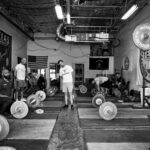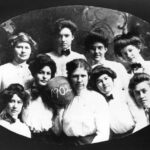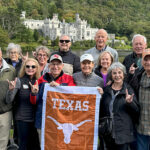How the Daytripper Became the King of the Road

Chet Garner is easy to track down these days. Pre-pandemic, the host and creator of the PBS show The Daytripper could usually be found, well, day tripping around the state. If you’ve ever seen the show, now in the middle of its 11th season, you’ve seen Garner doing some combination of the following in Amarillo or Tyler or Longview or another town in Texas you’ve always been meaning to visit but haven’t made it to yet: smiling as he devours brisket, smiling as he drains a cold beer, smiling as he shakes the hand of the local who slices his brisket or pours his beer. Over the course of 126 episodes, Garner, BS ’03, Life Member, has taken viewers to every corner of the state to see the beauty and mystery that Texas has to offer.
This past spring I catch up with him in, of all places, his house in Georgetown, Texas, over Zoom—the road warrior now sheltering in place. His well-worn Stetson rests behind him on a table, rendering it useless. There is no Gulf Coast or Big Bend sunshine from which he needs to protect his head. Or, rather, it’s still there, but the rays are out of range these days from where he sits in the home he shares with his wife and five children.
The man who makes his living being among strangers, eating barbecue at shacks or tip-toeing through rose gardens in far-flung places across the state, driving hours and hours for the sole purpose of feeling the air on his skin, is stuck inside with twice as many kids as adults.
Not that he’s complaining. The smile is still there.
“It’s this all day every day. It’s fun,” he says. “Is it fun? It’s definitely new.” And so, he soldiers on, looking over rough cuts from his editors, recording voiceovers, rewriting scripts, and managing his small Daytripper team remotely as he patiently awaits the return of what we can call, tentatively, “normal life.”

Garner spent countless hours on the road as a child. The son of a physician and a schoolteacher, he remembers packing into the family Suburban for trips around the state to visit relatives. He was born in Comanche, Texas, but raised in Port Neches, the southeasternmost corner of the state, a fateful notion, if you believe in such things. Because family trips began in the far reaches of Texas, that giant SUV was forced to traverse back roads for stretches upwards of six or seven hours at a time. Garner and his three siblings would fight over who got to sleep on the mattress tucked in the back.
By the time he enrolled at UT in 1999, he felt like he’d seen the whole state. How wrong he was. Because it’s what college students do, he backpacked across Europe and Asia, twice, eager to experience the world outside Texas. He enrolled in law school at Baylor and continued to travel, earned stellar marks, and landed a high-paying job at a law firm in Austin in 2006. A week or two in, he realized he hated his job. The paycheck was nice, but now that he was a practicing attorney, he was about to have all the money he needed to see the rest of the world and no time to do it. So, he and his wife Laura bought a house in East Austin and saved money while he hatched an escape plan. And in the meantime, he started taking trips around the state again, because he could do them quickly, in a day or weekend or so. He had an epiphany.
“I realized the stuff in Texas was as good or better than what I’d paid an expensive plane ticket to see overseas,” he says. “I was like, man, Texans need to know more about the state. There’s this treasure trove of stuff out there to explore. That was the impetus for the show.”
While working at the firm, he borrowed some camera gear from a friend and filmed the pilot episode for a new show called The Austin Daytripper. The idea was to film day trips within a two-hour driving distance from Austin. The first episode was shot in the summer of 2007 on his old stomping grounds: Waco.
“This was way before Chip and Joanna [Gaines] made Waco cool,” he laughs. “But I liked it. I thought, Waco, what a perfect subject. If I can convince Austinites to go to Waco, I can convince them to want to go anywhere in the world.”
He showed the pilot to PBS, and after securing a deal with the Austin affiliate to air his shows, he started cold-calling sponsors. “They are an outlet, not really a funder. Unless you’re Ken Burns,” Garner laughs.
PBS told him to secure a few sponsors at $50,000 a pop, and he’d have the funding needed to create a handful of episodes. But when the recession hit, he found that asking for $50,000 was a tall order. So, he dropped the number down to $2,000, the highest amount he felt a company would give him without asking too many questions. The first to bite was Chip McElroy, BA ’79, PhD ’89, owner of Live Oak Brewing Company, Garner’s hundredth or so phone call. He remembers being so surprised that he quickly jumped off the phone before he could sour the deal.
The first season featured five episodes, which aired in November and December of 2009. By then, Garner had left his day job and pushed all his chips to the center of the table. That meant the show needed to expand, so he asked the PBS stations in Houston and Dallas if they’d re-air his episodes.
“They said, ‘Let me let you in on something,’” he says. “‘The people outside of Austin aren’t in love with Austin the same way y’all think we are.’” He came back with a compromise: He’d drop Austin from the title and think about the state at large.
“I’m in Texas, in some random town, I’ll parachute in. What will I eat, see, or do if I’m in Marfa or Amarillo for the day? One day. Sun up, sun down. That’s what it morphed into.” Thus, The Daytripper was born.

Getting way outside of Austin was a challenge to his then-tight budget—the first five episodes were made for a total of $12,000—but he was compelled to get in the van and just go. It didn’t hurt that he actually believed in what he was peddling to audiences.
“I wanted people to not feel discontent that they can’t see the Red Sea,” he says. “You haven’t seen Matagorda Bay. Go down there. Find joy in the stuff you’ve written off because it wasn’t exotic enough. There’s stuff in your own backyard just as amazing—maybe more amazing—and it’ll help you feel a deeper connection to where you’re from.”
There’s never a good time for a global pandemic, and it will leave no one unscathed, but for those who depend on the travel industry to make a living, this moment can be especially scary. Garner, when we speak in April, is cheery and hopeful, despite being stuck in a holding pattern. His family is healthy, he has five new episodes of the show in the can that he filmed before quarantine, and, well, he’s just a generally pretty upbeat person.
“He is exactly like he is on camera,” says Kellie Baldwin, a former Daytripper intern and the current sound engineer for the show. “People ask, ‘Is that an act?’ No. That is absolutely Chet Garner, through and through. He’s funny, he’s quirky, he’s curious, he’s adventurous. And he wants people to come along with him.”
But summer is here, which is bad news for The Daytripper. The show films most of its episodes during this time, when there are longer days and more natural light, for efficiency’s sake. Most shoots last just two days and the small crew has to maximize its efforts.
For Garner, that paradox from when he was at the law firm has returned, but in a mutated way. He has the money to travel and all the time in the world to get out there, but he has nowhere to go, at least for now. On May 1, Gov. Greg Abbott, BBA ’81, Life Member, Distinguished Alumnus, announced certain businesses, restaurants included, could reopen (albeit at limited capacity). In early May, I speak with Garner for a second time. He has been poring over the news on re-opening, which seems to change weekly.
“The re-open orders have made it more likely that we’ll be shooting again soon,” Garner says, “but it’s still too early to say ‘let’s hit the road.’ It’s hard to social distance from a crew packed into a truck on the highway.”
Even if The Daytripper can’t get back out there in a timely manner, the show will go on. Garner will just have to improvise. They might shoot episodes piecemeal, and get what they can now—opening shots of city signs, state parks—and return for a second shoot when it’s safe to jump in swimming holes and share racks of ribs together.
“If things aren’t back to normal-ish soon, we’re going to have to get real creative with the way we make episodes,” he says. “But getting creative doesn’t scare me. The show started as an experiment in creativity.”
Top photograp by Matt Wright-Steel. Other photographs courtesy Hogaboom Road, Inc.









1 Comment